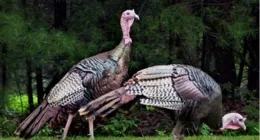If you lived in Marin prior to 1988 you remember a time when the only turkeys you saw were at the grocery store. This is because, in 1988, the California Department of Fish and Wildlife introduced wild turkeys onto Loma Alta hill on the west side of Lucas Valley. The idea was to provide hunting opportunities on private lands, and the turkeys have thrived. If you are a wild turkey, Marin is a perfect place to live and raise a family.
Wild turkeys are not native to Marin County

Turkeys make a mess in the garden
Perhaps the biggest complaint Bay Area gardeners have about wild turkey visitors is the mess they leave behind. Wild turkeys are omnivores and opportunistic feeders. They scratch around in the soil and among plants looking for food: insects, larvae, worms, seeds, soft fruits, nuts, plant matter, and sometimes small reptiles and amphibians.
They create a mess while they're at it, and they also leave their droppings behind. Turkeys are the largest game birds in North America, and their droppings are proportional to their size. Turkeys sometimes roam in gangs (yes. this is the proper name for a ”flock” of turkeys) numbering between six and 30, so it can get pretty messy.
Wild turkeys and their impact on the environment
The California State Department of Parks and Recreation has identified three potential negative environmental impacts caused by wild turkeys: their occasional consumption of endangered reptiles and amphibians, their competition with ground-dwelling birds for resources, and their contribution to the spread of sudden oak death. However, according to the California Department of Fish and Game, these effects are subtle and too difficult to detect in the short-term. To date, none of these concerns have been the subject of any comprehensive studies.
How to discourage wild turkeys from taking over your garden
If you don't want turkeys in your garden, don't feed them. The novelty of the birds sometimes inspires direct handouts, but more often they find spilled birdseed or unsecured garbage to eat.
The other thing you want to avoid is letting wild turkeys roost on your property. They usually roost in trees, but they can often be spotted on a roof or deck. The good news is they are relatively easy to move along. The Humane Society reports that making loud noises or giving them a squirt with a hose usually will do the trick.
Wild turkeys do have a pecking order of dominance and may view fearful behavior in people and pets as a sign that they are subservient. If a wild turkey or gang of turkeys have moved into your neighborhood or garden, you want to quickly establish your dominance by hazing the turkeys. Along with loud noises or hose squirts, the Humane Society also suggests popping open an umbrella, installing a motion-activated sprinkler, throwing tennis balls, or waving your arms while blowing a whistle.
During the mating season (February to May) male “tom” turkeys have been known to wander into neighborhoods looking for a mate. They may respond aggressively to their own reflection in windows and on shiny cars. Just haze the turkey away and think about covering the reflective surface. Although wild turkeys are large and can look intimidating, they are timid and scare easily.
Wild turkey behavior and antics
Instead of scaring turkeys away, you might choose to just relax, sit back, observe, and enjoy the ongoing antics of wild turkeys.
Male turkey (tom)

Male turkeys sometimes drag their wings on the ground while walking. If you close your eyes and listen, it sounds like a lady's long dress dragging across a dance floor.
Head and neck color changes
In addition to showing off their feathers, a male turkey's head and neck can go from gray and blue when calm, to bright red when angry or during courtship. Toms also have peculiar fleshy growths on the neck, under the chin and above the beak. The one in the throat area is termed caruncle. Wattles are located under the chin and the snood lies flapping on the beak. These growths are also normally gray or blue and can become bright red to display anger or to attract females.
Female turkeys (hens)

Gobble, cluck, and purr
Male turkeys can be a little noisy during the spring; they gobble, making a loud, rapid, gurgling sound to announce their presence to females.
Turkeys also make a clucking sound-- one or more short staccato notes to get attention. Sometimes a cluck is followed by a purr, a rolling sound indicating contentment.
Predators
While a hen can lay 10-12 eggs in the spring, there are lots of predators looking for an egg, tender poult, or adult turkey for dinner. Hens will double up with another hen for added supervision and protection of their poults. Wild turkey eggs, poults, and adult turkeys are threatened by numerous species, including snakes, skunks, opossums, raccoons, rodents, dogs, foxes, coyotes, bobcats, mountain lions, hawks, owls, crows, ravens, and eagles.
Original article by James Campbell for the Marin IJ
Edited for the Leaflet by Lisa MacCubbin

